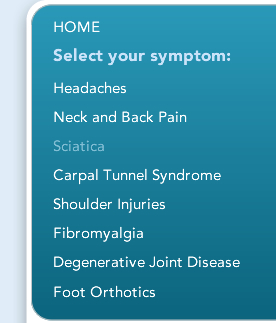172 Cambridge St. | Suite 304 | Burlington, MA 01803 | (781) 221-2295
What is Sciatica?
Sciatica is a severe pain in the leg caused by compression, irritation, or inflammation of the sciatic nerve. The sciatic nerves are the largest and longest nerves in the body, running down the back of each leg. Each sciatic nerve is composed of five smaller nerves that travel to the thigh, knee, calf, ankle, foot, and toes. When these nerves are irritated or affected by the inflammation of nearby soft tissues, doctors refer to this as sciatica.
Symptoms of Sciatica
People with "sciatica" can suffer a wide range of symptoms. Often pain will come and go. At times, it may be constant, but then it may subside for hours or days. Some people may feel only a dull ache or numbness, which travels down the back into the upper leg or butt. For others, it may be intense "shooting pains" down the leg into the foot and toes.
Many factors affect the pain of sciatica. Sitting in one position for long periods of time as when driving a long distance or working at a computer all day. Working out or running, or even just walking, sitting, bending, turning, or standing up may be difficult and painful. Tennis and golf are activities that can cause sciatica or a flare-up for the bending and twisting.
Causes of Sciatica
Because the sciatica nerve is so long, irritation can occur at many points. The first place may be the low back. Commonly a misalignment of one or more vertebra causing pressure on the nerve is responsible. This condition is known as a subluxation, one of the underlying causes of sciatica.
Another source of sciatica can be the disc involvement. Discs are the cartilage-like cushions occupying the spaces between vertebrae. Serving as spinal shock absorbers, they allow the back to turn and bend normally. Trauma or improper loading can cause a disc to bulge to one side resulting in herniated disc.
Sciatica has also been linked to various non-spinal conditions. Arthritis, advanced diabetes, tumors, constipation, and even vitamin deficiencies have been reported as causes. Degeneration of the spine resulting from long-standing or neglected back problems can also irritate the sciatic nerve. Pregnancy and childbirth can also cause sciatica.
Treatment for Sciatica
The medical approach managing sciatica is to treat the symptoms. This may include using pain killers, muscle relaxers or anti-inflammatory drugs. Traction, physical therapy, or injections directly into the nerve roots may also be used. In severe cases, even surgery may be tried.
The Chiropractic approach to treating sciatica is to find the source of nerve irritation and relieve the pressure causing the pain. By correcting the source of the problem, the body can heal naturally without the nerve interference. Treatment will vary according to the severity of the condition. With most patients, a series of adjustments to move the related vertebra back to a more normal position is helpful to reduce the pressure on the nerve. Physical therapy in conjunction with adjustments has proven very successful in treating most sciatica.

![]() Read our client testimonials | Send in your own: Email us at Life4orce4@comcast.net
Read our client testimonials | Send in your own: Email us at Life4orce4@comcast.net


